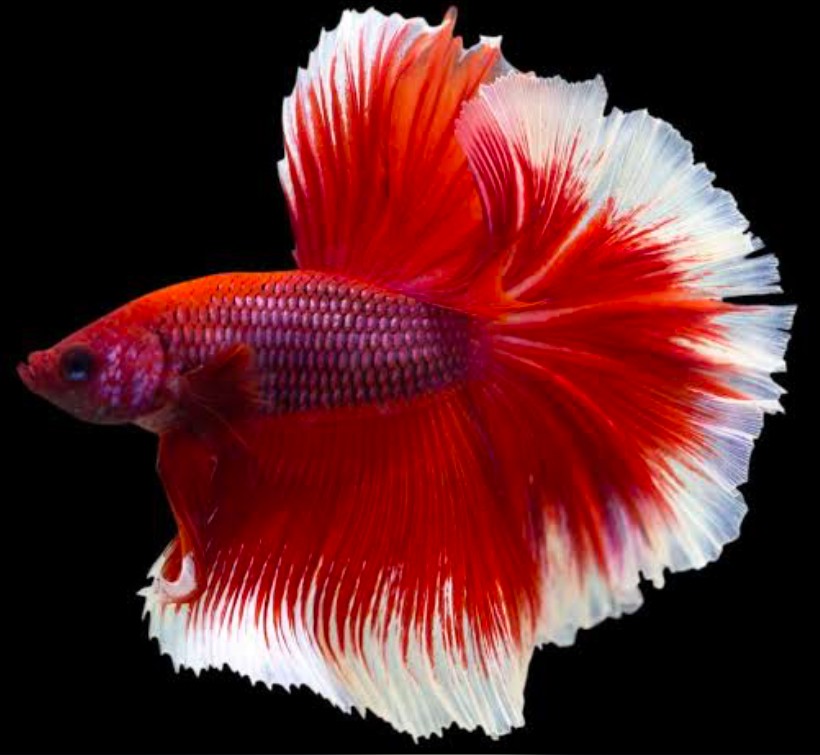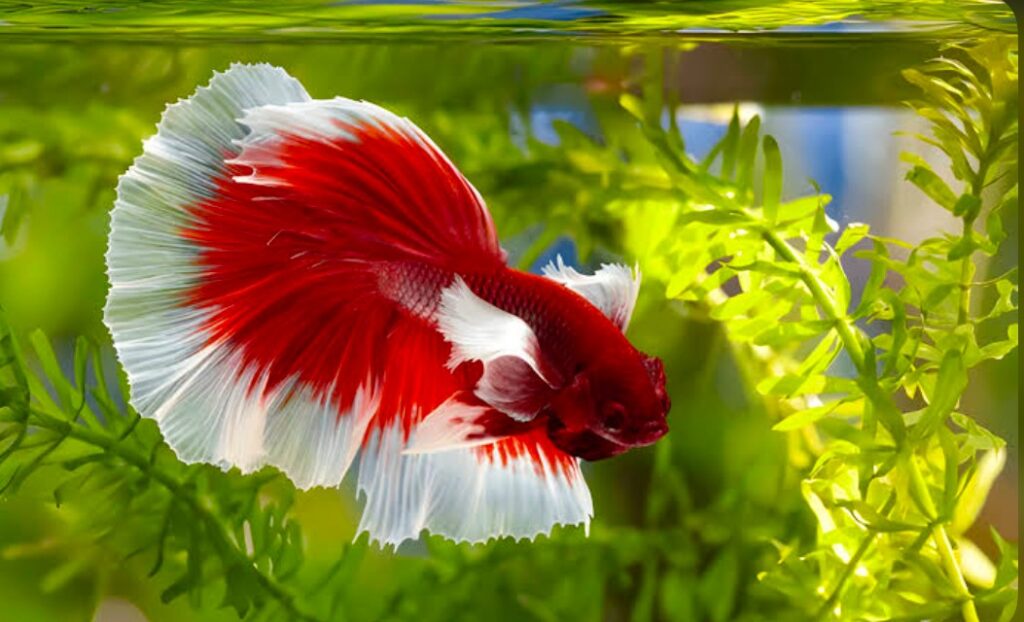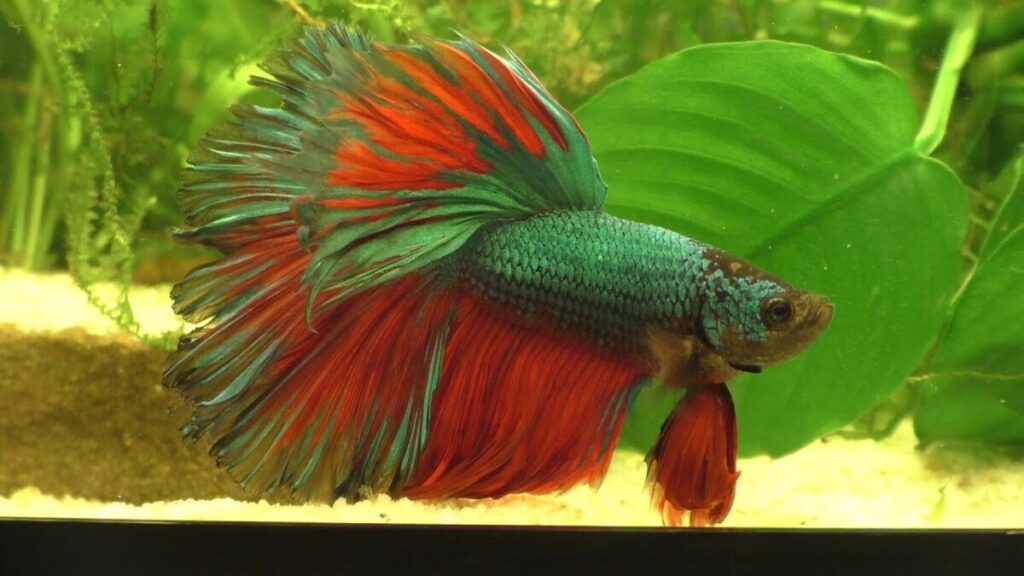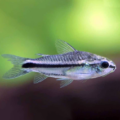Learn how to care for the sensitive Rosetail Betta fish in a home aquarium, including everything from feeding to breeding tips. As a bonus this guide will also detail tips for distinguishing between betta tail fin types.

Discover the Rosetail Betta: A Fin Display Like No Other
Of all ornamental Betta fish, the Rosetail species is one of the most visually stunning. That’s why it’s a common favorite for aquarium displays.
The Betta splendens Rosetail variety has unique features that distinguish it from other Bettas, such as excessive fin branching and distinctive red and white coloration.
In this Rosetail Betta fish overview, you’ll learn how to care for this aquatic beauty, which resembles a blooming rose when it swims.
Author’s Note: Check out our post on the The Top 10 Most Popular Betta Fish for even more beautiful Betta varieties!
Size, Structure & Fin Complexity of the Rosetail Betta

A closer look at this fancy-finned Betta fish, starting with its appearance, will help you better understand its unique needs.
An adult Rosetail Betta fish size extends between 2.5 – 3 inches in body length, while the tail and fin lengths vary based on genetics, diet, and environmental conditions. You’d notice that most Bettas have the same body length but differ in their tail shape.
Betta tail branching types vary from simple sharp edges to complex wide spreads, which is the appeal of the Rosetail species. Unlike Halfmoon, Rosetail Bettas have excessive branching that extends beyond 180 degrees. Its tail reaches its lower gills, and the edges are even, whereas the Feathertail has uneven branching.
Although it mostly comes in red or white coloration, the Rosetail Betta fish also has other color variations. It’s time to highlight ways to preserve this sensitive fish outside its natural habitat.
Aquarium Setup for Rosetail Bettas: Keep the Flow Low

Despite having excessive branch tail fins, Rosetail Bettas can thrive in a minimum 10-gallon tank as single adults. However, note these Rosetail Betta tank conditions to make them comfortable and allow natural behaviors with healthy growth.
Ensure minimal water movement and provide your Rosetail Betta with stable, warm water between 78 – 80°F, alongside the following water parameters:
| Parameter | Ideal Range | Notes |
|---|---|---|
| pH Level | 6.5 – 7.5 | Slightly acidic to neutral is best. Sudden pH swings should be avoided. |
| Ammonia | 0 ppm | Toxic even at low levels; must be zero at all times. |
| Nitrite | 0 ppm | Also highly toxic; should always be zero. |
| Nitrate | < 20 ppm | Safe in low amounts; regular water changes help control it. |
| Water Hardness (GH) | 3 – 4 dGH (50 – 70 ppm) | Moderately soft water is ideal. |
| Carbonate Hardness (KH) | 3 – 5 dKH (53 – 90 ppm) | Helps buffer pH and maintain stability. |
| Tank Size | Minimum 5 gallons | Larger tanks are easier to manage and better for Betta health. |
| Filtration | Gentle flow | Bettas prefer still or slow-moving water; use baffled or adjustable filters. |
| Water Change Frequency | 25–30% weekly | Helps maintain water quality and reduce toxin buildup. |
Use a gentle filtration in your aquarium setup to keep the environment clean without stressing your pet. Yes, filtration is needed for Bettas, contrary to popular belief.
Author’s Note: Check out our post on The 7 Quietest Aquarium Filters for a comprehensive guide on choosing the right filtration system!
Choose soft and safe betta tank decoration ideas to maintain an open swimming area where Bettas can display their branched fins without hurting themselves on sharp decor.
Use fine sand or smooth pebbles as substrates and well-rounded rocks with smooth driftwood for hiding spots and decoration.
Feeding Rosetail Bettas: A Diet to Support Delicate Fins

Provide a protein-rich fish diet for your Rosetail Betta, a carnivorous pet. Although they enjoy meat-based, high-protein diets in the wild, you may feed them a variety of foods under your care.
Mixed but rich nutrition for Rosetail Betta fish consists of high-quality Betta Pellets as staples, frozen bloodworms or freeze-dried foods as supplements, and occasional live treats like insects and larvae.
Author’s Note: For more on feeding your aquatic pets check out The Ultimate Guide to Fish Food: Pros and Cons & Best Choices!
When feeding fancy Bettas, stick to a routine to avoid overfeeding or malnutrition. Give them portions they can finish within 3 minutes to avoid waste contaminating the water.
Their bellies become distended or bloated when they overfeed, leading to discomfort and other health issues.
Common Health Concerns: Caring for Fragile Fin Royalty
Your Rosetail Betta may face other common health issues such as fin rot, tail biting, and stress from heavy fins, which come from not properly caring for long-finned Betta fish.
Thankfully, this Rosetail Betta health guide contains tips for preventing Betta fish illness, such as providing clean water, using gentle filtration to reduce stress, and feeding your pets a protein-rich diet.

Your work doesn’t end there. You must constantly inspect your Rosetail Bettas for signs of illness, whether it’s an infection, discoloration, or swim fatigue. Immediately quarantine the sick fish and administer first aid, such as improving the environment and diet. If the symptoms continue, please visit a vet for further testing.
Breeding Rosetail Bettas: Beauty vs. Genetics

Most ornamental fish reproduction results from selective breeding, and rosetail bettas aren’t different. Because it tends to have excessive tail branching, breeding Rosetail Bettas requires a careful selection of genes to avoid deformity.
Don’t breed two Rosetail Bettas; instead, pair a Rosetail Betta, whether male or female, with the features you desire and a true wild Betta.
These Betta genetic considerations reduce the risk of having deformed offspring.
Next, you must provide a conducive environment for proper growth after spawning. Male Bettas create a bubble nest for the females to lay their eggs and guard the fry. You must also ensure they develop properly by providing protein-rich food and keeping their environment pristine. Once they mature, you can move the Rosetail Bettas to a different tank.
Rosetail vs Other Bettas: How Do They Compare?
We can’t end this overview without comparing fancy Bettas similar to Rosetail to ensure you’re choosing the right species. I’ve chosen these three because they have similar Betta fish tail types, which leads to common care and popularity.
Rosetail vs Halfmoon Betta

| Betta Species | Rosetail | Halfmoon |
| Tail Structure | Symmetrical > 180-degree excessive branching | Symmetrical 180-degree spread |
| Care Needs | Stable flow78–80°F | Low Flow78 – 80°F Minimum of 10 gallons |
| Popularity | Visually striking but rare | Most Popular |
Rosetail vs Crowntail Betta

| Betta Species | Rosetail | Crowntail |
| Tail Structure | Widespread with soft edges Excessive branching from the lower gill to the tail | Narrow and Sharp Longer than Rosetail with less webbing between spiked rays |
| Care Needs | Gentle filtration Prone to fine rot and damage | Strong filtration Less prone to fin rot or damage |
| Popularity | Rare | Second Most Popular |
Rosetail vs Feathertail Betta

| Betta Species | Rosetail | Feathertail |
| Tail Structure | Excessive branching Longer than Feathertail | Ruffled Feathered Tail fin Edged fin |
| Care Needs | Wider space with a minimum of 10 – 15 gallons Highly sensitive and prone to fin rot from damage | Compact aquarium space of at least 5 gallons Gentle flowSoft Decor |
| Popularity | Rare | Rare |
Choosing Suitable Tank Mates for Rosetail Bettas
Would you like to build an aquarium community with your Rosetail Betta as the centerpiece? You can choose from the many peaceful tank mates for Bettas, whether they’re other fish like Pygmy Corydoras, snails like Mystery species, or Shrimp.
These slow-moving aquarium companions are ideal for pets because of their similar temperaments and physical appearance. They won’t stress your pet or harm them.
However, fin-nippers and fast-swimming fish may outcompete, bully, become predators, and cause stress to fail the Rosetail Betta compatibility test. So, avoid them.
Conclusion: Should You Add a Rosetail Betta to Your Aquarium?
These advanced Betta varieties require special attention due to their stunning appearance and delicate nature. They are also only suitable for aquarists who can provide a calm, clean, and spacious environment.
If you’re choosing Betta splendens for display tanks, then it’s the right decision. To give it the best life, feed it a high-protein diet, keep their water stable, and have only safe decor inside their tank.
That’s all you need to know about Rosetail Betta fish care in home aquariums. Follow this guide, and let us know how it helped you in the comment box below.











1 thought on “Rosetail Betta Fish (Betta splendens): The Flamboyant Flow of Aquarium Royalty”